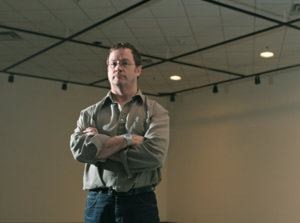The curator of Yukon’s public art gallery is leaving the territory feeling pride in his accomplishments over the past five years, and frustration over a blunder made decades ago.
“I’m disappointed the gallery isn’t being moved to the waterfront; I think that’s a mistake,” said Scott Marsden.
The gallery’s location — past the jail beside Yukon College in Takhini — is hindering its ability to grow and serve the community, he said.
While people will drive to the theatre, an art gallery relies on foot traffic.
“It has to be accessible to the public; it needs walk-in traffic,” he said.
In a year, about 9,000 people visit the public gallery.
“We’d have double that if the gallery was downtown. A lot of these people would love to walk into the gallery over their lunchtime.”
Putting the gallery on the waterfront would make a win-win situation for local business and culture.
The gallery would attract tourists and revitalize the downtown core, said Marsden.
Then the gallery space at the arts centre could be used to show works from the Yukon’s permanent collection (most of which are currently gathering dust in storage), First Nations art and cultural objects, or to exhibit touring museum shows.
Moving the gallery by the waterfront is “an opportunity to correct the mistakes of the past,” said Marsden.
“I think, realistically, we became a gallery of national significance under Marsden’s leadership,” said Yukon Arts Centre executive director Chris Dray.
“But he couldn’t resolve some of the traditional problems — like the fact that the gallery is in the wrong place.”
The art centre’s tale began almost 20 years before Marsden arrived on the scene.
In 1982, a group of local artists got together to find a new performance space.
Porter Creek’s Guild Hall was up and running at the time (it was created two years earlier) but was already too small, said Yukon Arts Centre executive director Chris Dray.
So the group, which became known as Arts Canada North, decided to create a new theatre space.
Those plans were shelved in ’83 with the closing of the Faro mine, only to reappear a few years later when then-premier Tony Penikett and the NDP government built Yukon College.
The government planned on building a theatre in the college, so it consulted Arts Canada North on the design.
Arts Canada North asked the community where it wanted the theatre.
And its overwhelming response was downtown.
The government didn’t have the money to build two theatres — one for the college and one for downtown — so Arts Canada North was left with only one choice.
“A number of people in the community were quite upset about that,” said Dray.
Originally the arts centre was only supposed to be the theatre, but the library, where the art was housed, needed more space for books and saw the art centre’s construction as a golden opportunity to build a public gallery and move the collection.
“The fact that we even got a Class A gallery was an accident,” said Dray.
Over the years, and through successive curators, the gallery has grown from being an afterthought to a main attraction.
Marsden came to the Yukon from Toronto five years ago to head the gallery.
“I didn’t really know much about the Yukon; in fact I didn’t even know where it was,” he said.
He took the job because he wanted to make a difference in the community.
“We’re sure to hell not there for the frickin’ money. We’re there because we believe that visual art can make a difference in peoples’ lives.”
The gallery’s mandate is to bring in contemporary thought-provoking work from Outside, and to give local artists their chance at tackling a solo show in a professional gallery.
Marsden has a handful of colourful invitations to exhibitions he’s programmed over his years to meet the mandate.
For example, 40 Part Motet by internationally acclaimed Canadian artist Janet Cardiff: “That’s what I mean about art having an effect on people’s lives. People would be crying and just taken away into another realm,” he said.
He has given local artists like Keith Wolf Smarch and Ken Anderson their first opportunities for solo shows.
The Road: Constructing the Alaska Highway, which exhibited last winter, was one of the most important shows Marsden programmed.
But the show he’s most proud of is yet to come.
Burning Cold, which is slated to exhibit during the Canada Winter Games, will compare young avant-garde artists from southern and northern Canada.
“It’s kind of my swan song,” said Marsden.
Marsden will move to Nanaimo, BC, next month to embrace a new challenge — combining two galleries, one downtown and one at the Malaspina University-College, into a single art space.
“The opportunity to build a gallery from scratch doesn’t come around often in a curator’s life,” said Marsden.
“It’s an opportunity for me to build something that I believe in.”
Meanwhile, the arts centre has appointed its former associate curator Mary Bradshaw to fill Marsden’s shoes for a one-year term.
Exhibitions are booked until 2010, leaving the gallery with time to plan its next move.
Dray wants to sit down with colleagues from Yukon’s art organizations, like SYANA and KIAC, to map the public gallery’s direction for the future before hiring a new director in a long-term position.
“We can decide where we want to go in the next few years because that will influence who we choose,” said Dray.
